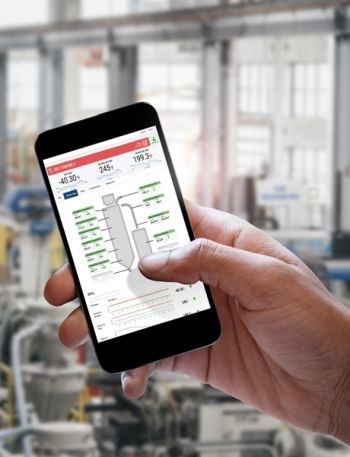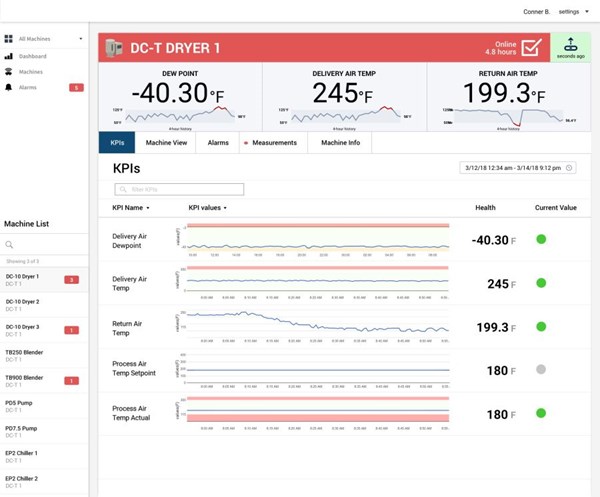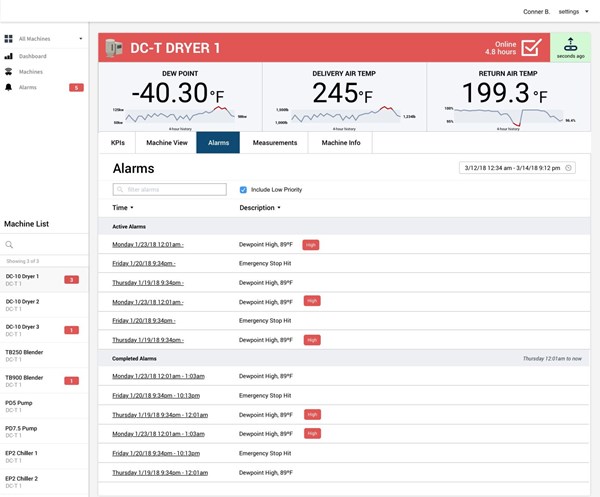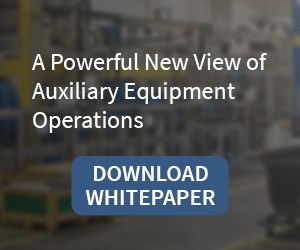Monitoring and Predictive Maintenance for all Your Auxiliaries on a Single Cloud-Based Platform
Sponsored ContentConair’s SmartServicesTM platform combines powerful equipment monitoring, visualization and notification functions with advanced cloud-based data storage and analytics. The Industry 4.0 platform promises new levels of process and quality optimization, predictive diagnostics and maintenance, and maximum equipment uptime.
Share

There’s a lot of talk these days about the potential of Industry 4.0, but many plastics processors are still wondering how that’s going to turn into something useful in their plants. Plastics auxiliary equipment manufacturer Conair has an answer for that with its new SmartServices initiative.
Unlike a lot of equipment monitoring systems today, SmartServices can bring virtually all your auxiliary equipment together into a single monitoring, analytic and predictive maintenance platform. Not only does it tell when your equipment is in good working order—and when it’s not—SmartServices provides the ability to benchmark your processes against a data pool of many other manufacturers. This intelligence delivers better uptime and reveals opportunities to optimize processes on your plant floor.
What really sets SmartServices apart is that it integrates with auxiliary equipment controls— both Conair’s and other brands—rather than just to individual sensors attached to equipment. It lets you follow what the operators are seeing in real time, all in one place, and even allows you to remotely adjust equipment settings where appropriate. For a process engineer or maintenance technician trying to keep up with dozens or even hundreds of pieces of equipment, sometimes across multiple plants, this visibility provides a new element of company-wide control, diagnostics and predictive maintenance that wasn’t available until now.
SmartServices can bring virtually all your auxiliary equipment together into a single monitoring, analytic and predictive maintenance platform. Here’s how it works.
How SmartServices Works
The platform starts with compact wireless machine adapters (WMAs) that connect auxiliary equipment controls via the web to the cloud-based SmartServices software. Conair says SmartServices interfaces with virtually all Conair equipment and with many auxiliaries sold by other companies as well.
Upon login, users identify and configure their auxiliaries into the system, organizing them however it is most efficient—by equipment type, plant names, production lines, physical locations—whatever customized format fits their operation. Once enabled, WMAs automatically collect data from each piece of auxiliary equipment and transmit it into the secure, cloud-based SmartServices database where it is processed and stored for presentation to the user.
The data stream along with operator settings automatically establishes a baseline of performance data for each piece of equipment that will be used later to help define normal operating conditions and identify when equipment is trending toward an out-of-tolerance condition. This enables the system to provide real-time intelligence for predictive maintenance or process issues—for example, when to change a filter—or to signal alarms on conditions requiring immediate action.

The KPI display makes it easy to scan current operating conditions
and spot performance trends. Both the highlighted KPIs and the time intervals shown on the line graphs are user-selectable and can be modified at any time.
The Conair SmartServices web portal streams user data into a dashboard format, providing a clickable list of the user-specified equipment groups on one side and a large working screen on the other. Within the dashboard, users can rapidly navigate to a selected equipment group and then drill down to Key Performance Indicators (KPIs) for each piece of equipment.
Display screens include:
- The KPI display shows real-time data. Each KPI is marked with a color indicator—red, yellow, or green—that makes it easy to assess current operating conditions and spot performance issues.
- The Machine View display shows a schematic of the equipment populated with readouts of setpoints and actual readings.
- The Alarms display offers real-time alarm status and a complete alarm history, together with a special panel that allows managers to create a hierarchy of alarm types, generate messages (texts or e-mails) specific to each, and direct/delegate alarm responses to selected individuals or groups of plant personnel.

The Alarms display offers real-time alarm status and a complete alarm history. Administrators can create a hierarchy of alarm types, generate messages (texts or e-mails) specific to each, and direct them to selected individuals or groups of
plant personnel.
This ability to custom configure notifications is particularly important to achieving an efficient system addressing equipment or production issues. For example, a material outage can be directed to production workers, equipment malfunctions to maintenance people, or more critical alarms to production supervisors. Moreover, the system provides timely intelligence to get at the root of problems. What may look like an empty blender may in fact be another issue, and that’s where you want to look first. In all these cases, it’s more likely issues will be addressed by the right people and problems will be resolved sooner.
A More Comprehensive Solution
Other equipment monitoring applications may be available for individual products, or for individual product segments, and may offer some of the elements found in SmartServices, but nothing compares to the comprehensive way in which this system can be used to manage such a wide range of equipment in a variety of locations. More specifically:
- It’s a platform for an entire plant—most predictive maintenance approaches still focus on individual pieces of equipment. SmartServices can integrate with almost any kind of auxiliary equipment.
- It’s a single system—no longer is your process information spread across multiple apps. All data flows into a single dashboard.
- It’s built for growth—for many processors, a good first step is getting data streaming to enable equipment monitoring, establish operating baselines and trigger alarms for non-conforming conditions. But achieving true predictive maintenance is not far behind, and better data will indeed lead to process optimization for those inclined to act on this information.
Moreover, because the SmartServices application is cloud-based, you won’t have to worry about software upgrades. Conair will continue to develop the system over time, and as the body of actionable process data grows, as well as the IIoT capabilities of the equipment, SmartServices will grow with them.

SmartServices interfaces with virtually all Conair equipment and with many auxiliaries sold by other companies as well.
A Platform for Continuous Improvement
A particularly promising aspect of the SmartServices platform is the visibility it provides on how processors’ performance data compares to the collective data of others (anonymously) using similar equipment. Even as individual users interact with their own data, the platform collects, analyzes and stores performance data from thousands of other connected processors worldwide. The result is an ever-growing auxiliary equipment performance database that can be leveraged by both the processor and Conair personnel to improve efficiency, performance and uptime. Already, that information is beginning to be mined and used to develop algorithms for a range of predictive, diagnostic and comparative purposes such as:
- Real-time performance comparisons between selected individual auxiliaries and a global average;
- Understanding and predicting power consumption of auxiliaries at given performance/output levels;
- Identifying equipment in need of specific preventive maintenance based on performance history and operating characteristics.
With this growing world of data, individual processors can get a sharper picture of how to affect real process improvement on their own factory floors.
The Uptime GuaranteedTM Promise
Standing behind the SmartServices platform is Conair’s own team of process and service engineers. The company can even monitor the system for you if that’s what you want. A 24/7 Instant Access Hotline makes part replacement or service just a call away. In addition, Conair’s service technicians work from an inventory of more than 50,000 line items—over 1.5 million parts total. The company ships nearly 90% of parts orders within one business day and usually within 6 hours. If on-site assistance is needed, Conair’s team of field service professionals includes almost 40 members.
In fact, Conair is so confident in its ability to keep auxiliary equipment up and running, it now offers an “Uptime Guaranteed” promise on its new equipment that includes:
- 99% uptime on all Conair equipment
- Customer service contact within 15 minutes
- Parts ship within 6 hours
Using SmartServices, Conair can tell customers exactly how close to 100% uptime they can expect from their existing equipment, based on their process parameters and other factors. Using this data, Conair can then guarantee the uptime percentage, whatever it may be. If the equipment doesn’t meet those benchmarks, Conair will take ownership of the problem, such as fixing or replacing equipment if required.
For all the capabilities of the SmartServices platform, Conair stresses that they are just getting started on tapping the potential of this technology. With continued development, Conair envisions a wide-ranging package of integrated, “smart factory” services, all informed by data and validated by analysis, to ensure optimal equipment performance and support quantifiable equipment uptime guarantees.
For more information on Conair SmartServices, or to sign up for a 6-month free trial, visit www.conairgroup.com/smartservices.
